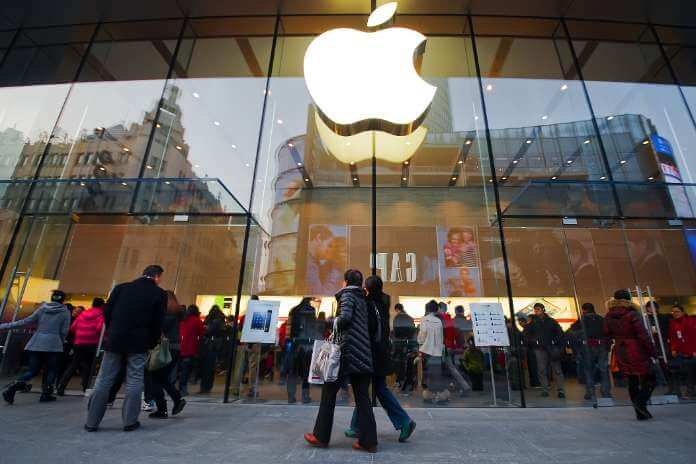I have a strong sell recommendation on the S&P 500 (SPY) and the NASDAQ 100. (QQQ). It is worth noting that Apple (NASDAQ:AAPL) accounts for about 14% of QQQ by weight and nearly 8% of SPY – the essential Company in each of these extensive stock market indexes. As a result, I am implicitly advocating a sell on AAPL, as it is difficult to imagine a substantial decrease in SPY and QQQ without at least a moderate drop in AAPL.
As a result, it is critical to examine Apple on its own to assess whether the bear argument for the broader market is valid. Please remember that this is a top-down examination of a single stock.
The bottom-up strategy often begins with the Company, examining the many firm-specific characteristics (product, services, management, ratios…). The top-down strategy starts with a comprehensive macro analysis (based on monetary/fiscal policy, trade policy, and geopolitics), then moves on to the impact on various sectors and, eventually, individual stocks.
Is Apple’s stock recession-resistant?
The top-down strategy for studying individual equities boils down to calculating the likelihood of an impending recession and assessing how the expected recession will affect individual stocks.
So, let us begin by debating whether a prospective recession would negatively impact Apple’s financial performance. Rather than attempting to establish a judgment on the subject, I am curious to see what the Company has to say regarding the impact of market risk (systemic risk) on the Company’s financial performance. I obtained the most recent AAPL annual report (10K statement) and searched for the “risk factors.” This is what I discovered (author’s bold text): Apple Inc. | Form 10-K for 2021
Global and regional economic conditions heavily influence the Company’s operations and performance, and poor economic conditions can significantly negatively impact the Company’s business, results of operations, and financial position.
The Company has worldwide activities, with sales outside the United States accounting for the bulk of total net sales. Furthermore, the Company’s worldwide supply chain is broad and complicated, with most of its supplier facilities, including manufacturing and assembly locations, situated outside the United States. As a result, global and regional economic conditions substantially impact the Company’s operations and results.
Inflation, slower growth or recession, new or increased tariffs and other trade barriers, changes in fiscal and monetary policy, tighter credit, higher interest rates, high unemployment, and currency fluctuations can all negatively impact demand for the Company’s products and services. Furthermore, consumer confidence and spending might suffer due to financial market volatility, unfavorable financial news, real estate, and mortgage market circumstances, income or asset value decrease, changes in fuel and other energy expenses, labor and healthcare costs, and other economic issues.
In addition to having a negative impact on demand for the Company’s goods, uncertainty about or a decrease in global or regional economic circumstances can have a major impact on the Company’s suppliers, contract manufacturers, logistics providers, distributors, cellular network carriers, and other channel partners. Financial instability, difficulty acquiring credit to finance operations and purchases of the Company’s products, and insolvency are all potential consequences.
A downturn in the economy can also result in higher credit and collectibility risk on the Company’s trade receivables; the failure of derivative counterparties and other financial institutions; constraints on the Company’s capacity to issue additional debt; lower liquidity; and decreases in the fair value of the Company’s financial instruments. These and other economic conditions can significantly negatively impact the Company’s business, results of operations, and financial position.
So, without providing my judgment, I deduce from Apple’s management discussion that a hypothetical recession would “materially negatively affect the Company’s business, results of operations, and financial condition” through a variety of channels, including decreased consumer demand, higher interest rates, greater credit risk, a stronger USD, worldwide demand…, the list is extensive. According to the “risk factors” remark, Apple management does not believe Apple stock is recession-proof.
What is the probability of an imminent recession?
Given that AAPL is unlikely to be recession-proof, the top-down technique may be used to forecast its performance. The crucial element is estimating the likelihood of a recession correctly.
Again, we may acquire the recession likelihood straight from the NY Fed without having to form a judgment on an impending recession. The NY Fed used its logit model to forecast the likelihood of a recession over the next 12 months purely based on the spread between the 10-year Treasury bond and the 3-month Treasury bill. The recession likelihood grows when the 10y-3mo spread narrows towards zero. When it inverts to a specific threshold, an impending recession becomes nearly probable (very few false signals over a long period). In particular, when the projected recession risk surpasses 30%, a recession has occurred in all situations since 1961.
The NY Fed’s recession probability is 25.149% as of September 9, 2022. The 10y-3mo gap has shrunk since then, although it is still encouraging. However, as the Fed raises short-term interest rates on September 21, the 10y-3mo spread is expected to invert, pushing the recession probability beyond the 30% mark and signaling an impending recession.
What kind of Company is Apple?
In the grand scheme of things, Apple is fundamentally a one-product firm. According to the most recent quarterly report, Apple 10Q July 29, 2022, iPhone accounts for about 50% of Apple’s revenues. Services account for approximately 25% of total sales, although these services are tied to the iPhone. Other goods are expected to be part of the iPhone ecosystem as well. (There is “someone I know” who has to buy a new laptop for school purposes, and when asked what sort of laptop he wants, the person responds Mac, so it can be connected to his Apple AirPods, which work with iPhone. And the same guy keeps requesting that I purchase extra cloud storage for his iPhone.)
Apple is also a global firm, with over 50% of revenues coming from the Americas, nearly 25% from Europe, and more than 15% from China. As a result, Apple is considered vulnerable to the dreadful economic situation in Europe, the geopolitical scenario in China, and the deteriorating economic position in the United States. As a result, Apple is dangerously exposed to the poor economic condition in the United States and worldwide. Analysts anticipate that Apple’s EPS will rise from $6.10 in 2022 to $6.44 in 2023, a 5.5% increase. Given the significant likelihood of a recession within the next 12 months, I believe this is an unreasonable projection. Not only should analysts reduce profit growth, but they should also consider factoring in earnings declines over the following 12 months, in my opinion.
More crucially, Apple’s future PE ratio, which considers current profits growth, is 24. This is probably overpriced for a firm with modest growth in its main product. However, given the extremely high likelihood of a recession, those predicted earnings will almost certainly be lowered, necessitating a significant price reduction, in my opinion.
Implications
According to the “risk statement” in Apple’s 10K filing, the Company is unlikely to be recession-proof. The likelihood of an impending recession is now relatively high. As a result, Apple’s financial performance is expected to suffer if a downturn occurs during the next 12 months.
On the other hand, Apple’s stock is unlikely to be priced for a recession. The value measures remain stretched, yet analysts continue to forecast 5.5% EPS growth in 2023.
As a result, I believe Apple’s stock has a substantial downside. Profit estimates likely reflect an impending recession, and the valuation multiple is expected to be reduced.
Featured Image – Megapixl © Hanhua















